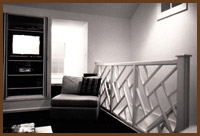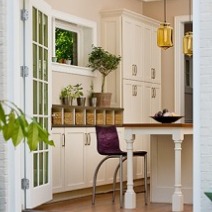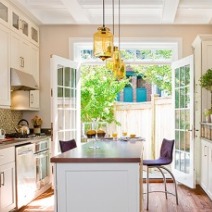Attic Conversions: From Storage Space to Living Space
Outgrowing your home and need more space for a bedroom or a home office? Your home may be hiding the perfect space to carve out new rooms. Take the attic, for example. Many homes have sufficient ceiling height, a proper stairway, and conventional roof rafters. This means converting the attic into a livable room is not only a great way to expand space, but may be possible at a reasonable remodeling cost.
Visit our portfolio to see spaces we have reconfigured and contact us to schedule an initial consultation—or keep reading to learn more!
As a basic rule of thumb for attic remodeling, features that minimize remodeling costs include:
- A ceiling height of 7’6″, which is considered a minimal legal height
- A staircase at least 36″ wide with stair risers and treads that meet current code
- A bedroom egress window that satisfies current building codes
These three features will allow you to remodel your attic in a cost-effective way. Insulation, drywall, electrical outlets, lighting, carpet and paint, along with a simple heating and cooling system are all you need to make your attic livable. Space reconfiguration like an attic conversion can be extremely beneficial – and more economical than building an addition!
Attic Remodeling Considerations
No matter the type of attic renovation, it’s a smart way to add usable space to your home. Here are some other important points to consider when thinking about converting that dingy attic space into a beautiful bedroom or functional home office.
Staircase
If your home does not have a proper stair to the attic, you’ll need to install one. This is a complicated process both in terms of structural floor framing and the use of space. The most efficient way to install a staircase is to place the new stair over the top of the existing stair. If placing the stair over the top of the existing stair does not fit in your home, find a location that minimizes the amount of space it takes from existing rooms. A typical house requires about ten linear feet of space for a stair. Stair dimensions are critically important so be sure to have your architect figure out the floor-to-floor dimensions along with proper risers and treads so it’s safe and meets code. Avoid pie shaped treads (winders) whenever possible because they may not meet local building codes.
As for ceiling height, make sure yours meets the legal minimum; this prevents problems with current building codes – and bumping your head! Also install proper handrails at the new stair and at the new stairwell opening – your design-build team should specify guard rails as per code. You want your new living space to be not only aesthetically pleasing but safe and fully functional as well.
Shed Dormers
Shed dormers are a great way to increase the usable floor area of an existing attic and potentially add ceiling height. Shed dormers are typically built at the rear side of a home with a gable or hip roof so as not to harm the curb appeal of the home’s façade. Shed dormers can be any width but are typically constructed the full length of the house from side to side to maximize usable space. Occasionally a small shed dormer (6 feet wide or so) will be built to accommodate head room at the top of a stair or an attic bathroom. Shed dormers are typically sloped down toward the back wall of the house, but the shed roof could be pitched up toward the window wall to achieve greater head room within the dormer.
By Replacing Roof Trusses
with Standard Roof Joists,
This Attic Conversion Created
New and Livable Den Space
Roof Framing
Most homes built prior to the 1970s were built with conventionally framed roof structures utilizing roof rafters (typically 2x10s) placed 16 inches on center. Conventionally framed roof structures are easier to modify for a new shed dormer. Although the rafters will have to be altered and supplemented, it’s easier than reconfiguring a 2×4 truss roof of more recent construction. Homes built after the 1960s were often built with 2×4 roof trusses that make using the attic space very difficult.
The Wentworth design-build team has removed trusses and inserted conventional rafter framing to free up the attic space, but a truss roof is more tricky and expensive to remodel than one with traditional framing. Furthermore, because a new dormer roof often bears on a roof’s ridge beam, it’s important to do a structural analysis. In older masonry homes the ridge beam rests on brick and block walls, which carry the roof load down to the foundation. If the house is of frame construction or brick veneer over frame, the ridge beam must be supported structurally down to the foundation. When undertaking this type of project, we always consult with a structural engineer prior to construction to ensure the best results.
Floor Framing
It is also important to know the typical attic floor was not framed to support living spaces and what the building codes refer to as a “live load.” Most attics were built for the purpose of modest storage, but don’t let that discourage you from completing your attic remodeling project! Attic floors must be reinforced with additional floor joists, cross bracing or blocking. On occasion, additional plywood subflooring will also stiffen the floor plane. And a roof was framed with 2×4 trusses has no proper floor structure, which means a floor has to be framed. A structural engineer should review and approve any floor or roof structure design.
Bathrooms
When converting an attic to a living space or bedroom, most homeowners want to add a bathroom. The addition of a bathroom makes the attic more convenient and livable. A full bath with a shower or tub is normally preferred, and this type of modest bathroom normally requires a 5′ x 8′ space. Attic baths at a third floor location do not need to be palatial since they seldom receive as much use as a bath located on the bedroom floor or in a master bedroom area. Again, if possible and practical, it’s best to place the new bathroom over the top of an existing bathroom because it minimizes plumbing lines.
Storage under the Roof
Attics built within a gable or hip roof provide excellent storage opportunities. The small low triangular spaces that are left over around the perimeter (beyond the knee wall, ideally 4 feet high) are easily turned into storage closets for suitcases and other items homeowners wish to tuck away. We often design dressers and bookcases that are recessed into these bonus spaces. If the space below the roof is tall enough it can even be used for a closet. And the low perimeter area beneath the roof is a perfect place to unobtrusively run ductwork.
Heating and Cooling
Of course your new attic space can be tied into your existing forced air heating and cooling system – if the old furnace and air handler unit has sufficient capacity. But most often it won’t. Ideally the new attic space should have its own heating and cooling system. Due to its location right under the roof, an attic demands more cooling to keep the space comfortable in the summer months. Heat will be less of an issue because heat rises and the attic will benefit from the main house heating. For this reason, a more modest approach can be taken with heating. Gas fired forced air, electric heat pumps and radiator heating all work well in an attic conversion, and you should talk with your design-build team about creative and cost-effective options for heating and cooling your space.
Attic Renovation in the Washington, DC Area
Converting your unused space into usable living space is a great idea, but it can be complicated. We recommend talking with an experienced and licensed architect about your home remodeling needs to find out what your project will entail. To speak with Wentworth about an attic remodeling, contact us today.









